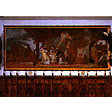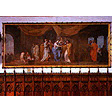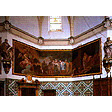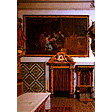
Goya and the Carthusian
church of the Aula Dei (Zaragoza)







 |
On the walls of the church of the Carthusian monastery of the Aula Dei, Goya painted a cycle of scenes in oils of the Life of the Virgin Mary. It is the most extensive of his works, although of the eleven passages, only seven remain and some of those with partial losses. The cause of this damage was the abandonment of the monastery caused by the Desamortizacion de Mendizabal 1 in 1836. The north side, the area around the entrance and the greater part of the south transept are what remain of the painted parts of the monastery.
The cycle was painted between 1772 and 1774, dedicated to the Virgin Mary, the patroness of the Carthusian Order. In the cycle Goya used two styles: the late Baroque and Rococco, in which he had been trained, and the Classical, which he had assimilated during his travels in Italy. The first can be clearly seen in the Purification of the Virgin or Presentation of Jesus in the Temple, or in the Adoration of the Three Wise Men. The Classicism can be detected in certain figures and compositions such as the The Wedding of the Virgin, or the Visit of Mary to her Cousin Isabel. In these scenes there are realist details such as two children fighting over who is to carry the wedding train. These scenes fall within the best tradition of Spanish naturalism and foreshadow Goya's later work. The scenographic effect of the compositions are striking, with a composition that is solemn and well-balanced. The figures are created with broad brushstrokes, giving them a clear and substantial volume and shape. The Aula Dei cycle, to which insufficient attention has been paid by scholars, is the culmination of the younger Goya's work and the prelude to his artistic maturity. Paintings of the Carthusian church of the Aula Dei
Arturo Ansón |
|
| Announcement to St. Joachim and St. Anne by the angels |  |
|
| Birth of the Virgin |  |
|
| The wedding of the Virgin |  |
|
| Visit of Mary to her Cousin Elisabeth |  |
|
| Circumcision |  |
|
| Presentation of Child Jesus in the Temple |  |
|
| Adoration of the Three Wise Men and Epiphany |
 |
InfoGoya 96 is an initiative of the University of Zaragoza, sponsored by the Institution Fernando el Católico of the Deputation of Zaragoza on an Apple Internet Server donated by Apple Computer. |    |